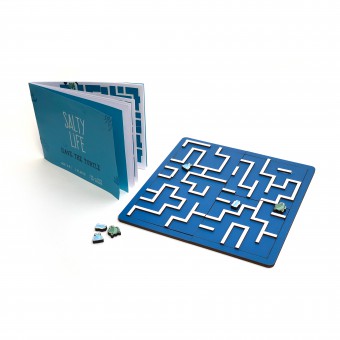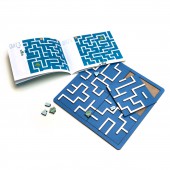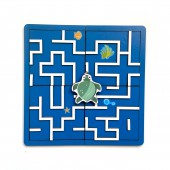
| THE AWARD |
| CATEGORIES |
| REGISTRATION |
| SUBMIT YOUR WORK |
| ENTRY INSTRUCTIONS |
| TERMS & CONDITIONS |
| PUBLICATIONS |
| DATES & FEES |
| METHODOLOGY |
| CONTACT |
| WINNERS |
| PRESS ROOM |
| GET INVOLVED |
| DESIGN PRIZE |
| DESIGN STORE |
| THE AWARD | JURY | CATEGORIES | REGISTRATION | PRESS | WINNERS | PUBLICATIONS | ENTRY INSTRUCTIONS |
Save The Turtle Puzzle by Christine Adel Zaghloul |
Home > Winners > Design #98043 >Interview |
 |
|
FS: What is the main principle, idea and inspiration behind your design?
CZ: The puzzle aims to educate children about the harmful impact of our human waste, especially plastic on other creatures such as sea turtles in a playful way they understand. Zagazoo Team therefore wanted to present this important idea and global situation in a fun and playful way that children understand, since it’s tackling two topics many children love and definitely relate to: animals and sea/ocean. Solving a puzzle multiple times helps reinforcing the knowledge through repetition.
FS: What has been your main focus in designing this work? Especially what did you want to achieve?
CZ: The main focus was to create a flexible maze puzzle, that can have “endless” layouts yet easy for children to assemble, play with and learn from. We wanted children to understand this environmental topic through play and pass it on to others. Zagazoo wants children to become more environmentally aware. Save The turtle” helps children to have an/a better understanding of this important environmental issue and therefore be able to change their everyday behavior towards using plastic and dealing with waste in general.
FS: What are your future plans for this award winning design?
CZ: This design is just the beginning to raise awareness about the harms of plastic and human waste. Zagazoo Busy Bags wants the game to be a method of educating children globally about the environmental problems the earth is facing. The game can also be developed to be played by older age groups and in different ways.
FS: How long did it take you to design this particular concept?
CZ: It is hard to tell, but it took around 10-15 days to have the design ready and another 10-15 days to have it produced.
FS: Why did you design this particular concept? Was this design commissioned or did you decide to pursuit an inspiration?
CZ: Zagazoo pursuit to design this particular concept, because it was among a set of games that introduced to children different concepts about the sea/marine life and the other reason is that we, as a team, deeply believe in the cause and message the game is delivering. Introducing the marine life without tackling the environmental problems wasn’t possible. The design is an exclusive idea by Zagazoo Busy Bags and is aimed to educate children and change their behavior towards the environment.
FS: Is your design being produced or used by another company, or do you plan to sell or lease the production rights or do you intent to produce your work yourself?
CZ: So far, Zagazoo would care to keep the creative copyrights for itself, because of the exclusivity of the idea. But exploring other options in the production can always be a question, since there is always something to iterate and improve.
FS: What made you design this particular type of work?
CZ: Zagazoo specializes in edutainment games and activities, so Save The Turtle is an example of the kind of work that is produced by Zagazoo.
FS: Where there any other designs and/or designers that helped the influence the design of your work?
CZ: Zagazoo co-founders (Christine and Marina Zaghloul) worked on the design together to come up with a design that is easy to produce with a laser cutter and package in a portable pouch. The square pieces needed to be identifiable for the smaller children, too. It was hard to find an inspiration in existing toys/games, because they are manufactured differently.
FS: Who is the target customer for his design?
CZ: Children age 4-9.
FS: What sets this design apart from other similar or resembling concepts?
CZ: Raising awareness about environmental topics through a maze puzzle is not a common game/toy concept especially for preschoolers and children. So, the purpose is not only to tease the brain and make the children think about a maze solution, but rather to keep them aware and informed about an existing environmental problem.Regarding the design itself it’s also different, because it combines the maze and puzzle concept together in one game which gives the game extra mystery and complexity. Adding to that the game has 2 levels which makes it more challenging and suitable for a wide age group.
FS: How did you come up with the name for this design? What does it mean?
CZ: The name "Save The Turtle" indicates the function the children need to be doing in order to win, they need to save the sea turtle from the harmful plastics. Solving the maze puzzle is about taking the sea turtle to a safe place away from the plastics (Level 1) and finding the path that leads the sea turtle to a safe place without passing by the plastic bottle/bag (Level 2).
FS: Which design tools did you use when you were working on this project?
CZ: This design was mostly designed on Adobe Illustrator.
FS: What is the most unique aspect of your design?
CZ: The design has a unique message to deliver, is space saving and based on a simple module/grid that gives multiple solutions and quizzes.
FS: Who did you collaborate with for this design? Did you work with people with technical / specialized skills?
CZ: The design was done in-house and the wooden pieces were produced in a small local workshop and the booklet in a print house.
FS: What is the role of technology in this particular design?
CZ: The technology that was mostly used is the laser cutter. It was used to produce multiple prototypes to find out the best and most economic outcome with as little waste as possible.
FS: Is your design influenced by data or analytical research in any way? What kind of research did you conduct for making this design?
CZ: Data was mostly collected after the first prototype was produced. The team was then able to test the game with children and to collect insights about their familiarity with the topic and how they got along playing Save The Turtle. After getting the first feedback through the testing, the team modified the colors and product design by adding more elements that make the game more understandable and functional.
FS: What are some of the challenges you faced during the design/realization of your concept?
CZ: One of the main challenges was creating an economic design and finding the suitable supplier that can manufacture the product and produce the first prototype. Another challenge was to create a smart solution to make the puzzle packable and portable with the least space consumption (after all it needs to fit in a small pouch). Creating a game/toy that is based on geometric modules can be visually boring to younger children, so it was a duty to make the product as appealing as possible. The final challenge was to make each puzzle piece distinctive from the other, so that younger children (age 4+) would be able to assemble the pieces, too. This was achieved by simply putting stickers, to make each puzzle piece unique.
FS: How did you decide to submit your design to an international design competition?
CZ: Zagazoo wanted to prove to itself and to future customers that it can create valuable and international-standard games/toys and to gain a global recognition from international entities.
FS: What did you learn or how did you improve yourself during the designing of this work?
CZ: Zagazoo learned to keep on improving its designs even after the first batch is out, each time there is a new finding or feature to add. Listening to the customer's feedback is key.
FS: Any other things you would like to cover that have not been covered in these questions?
CZ: Zagazoo will always be keen to adapt new, available and affordable technologies. This design was done using minimal resources and local workshop with few tools.
FS: Thank you for providing us with this opportunity to interview you.
A' Design Award and Competitions grants rights to press members and bloggers to use parts of this interview. This interview is provided as it is; DesignPRWire and A' Design Award and Competitions cannot be held responsible for the answers given by participating designers.
| SOCIAL |
| + Add to Likes / Favorites | Send to My Email | Comment | View Press-Release | Translations |





